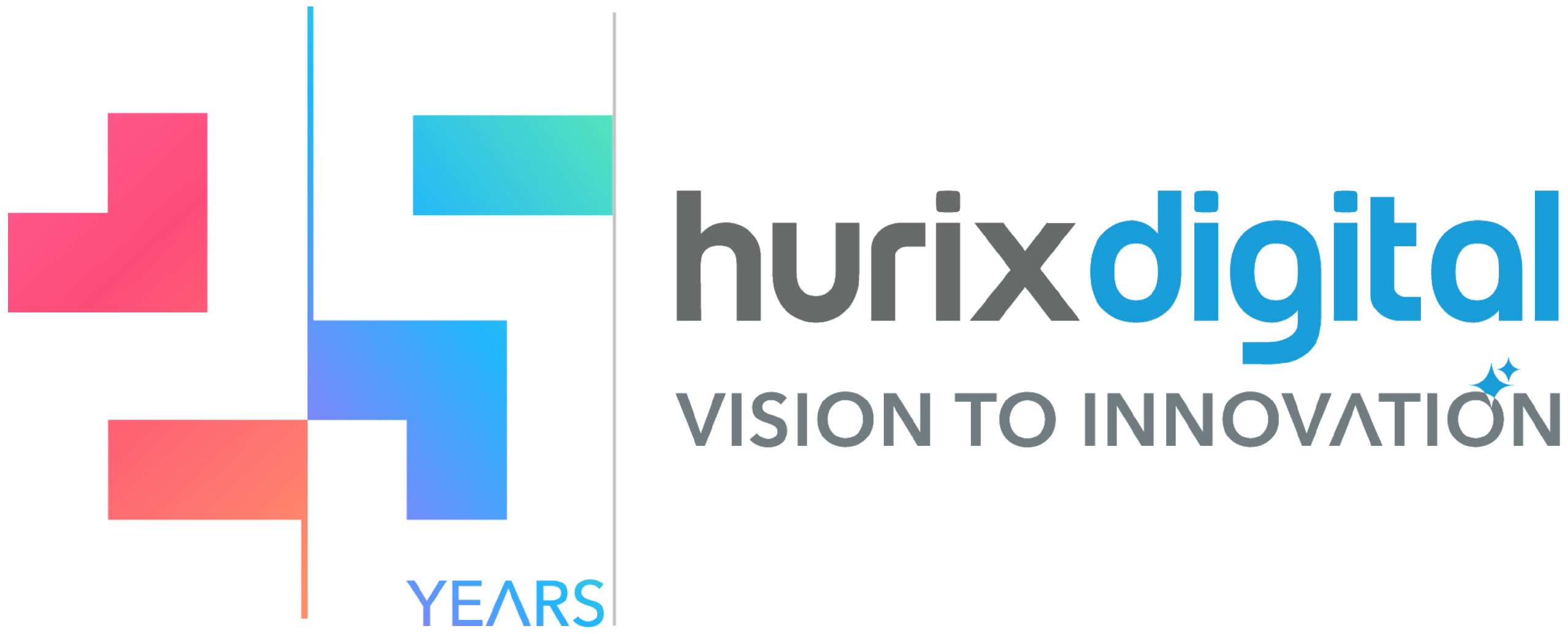
The Future of Student Assessment Beyond Traditional Methods
Summarize with:
Assessments have double benefits: one, they enable educators to understand how well their students grasp a lesson, and two, they reflect a student’s weaknesses and highlight the areas they need to focus on.
As such, every digital course is accompanied by a series of assessments that students take at various stages during the course. However, for educators in particular, it could get a little difficult to manage the lessons and assessments for every individual student, especially since each course can be personalized and custom-paced.
This is where assessment management enters the scene. These online assessment platforms help educators and students maximize the value of their learning courses by reflecting on their true progress and performance. In this blog, we will explore more about assessment platforms.
Table of Contents:
- What is Assessment Management Software?
- What is Authentic Assessment?
- Traditional Assessment vs. Authentic Assessment
- Why Teachers are Shifting to Authentic Assessment
- Important Features of Assessment Management Software
- How Does AMS Help Students Enhance Learning?
- Understanding Rubrics in Education
- Key Components of a Rubric
- Advantages of Implementing Rubrics in Academic Assessment
- Wrapping Up
What is Assessment Management Software?
Assessment management software is a tool that enables educators to streamline student assessment processes during a digital course. It empowers educators to execute a more thorough, accurate, and exhaustive evaluation of the academic performance and development of the students enrolled in a course.
The insights this software delivers help students see their performance parameters in a new light. Using these insights, educators can guide students on the right path to improving their understanding of a lesson without them falling behind on coursework.
It may even help educators create healthy competition among the students of a course.
What is Authentic Assessment?
In definition, authentic assessment is the evaluation of intellectual accomplishments that are meaningful.
The method contrasts with traditional assessment methods, such as MCQs and memorization exercises. It pushes students to implement their learnings into practice.
Unlike traditional assessments, it requires learners to engage in realistic and diverse scenarios. The method focuses on improving learners’ critical thinking and problem-solving skills, which increases their chances of addressing real-world problems.
Let’s get a better understanding of the difference between the two.
Traditional Assessment vs. Authentic Assessment
Here are some key differences between traditional and authentic assessment:
| Traditional Assessment | Authentic Assessment |
| Relies on written measures and forced choices | Implements multiple measures, both performance-based and written |
| Focuses on proxy measures of learning for target skills | Encourages direct measures of targeted skills |
| The objective is to evaluate the acquisition of knowledge | The goal is to develop meaningful learning and skills |
| Encourages the “what” | Promotes the “how and why” |
| Prioritizes summative product or outcome | Priorities learning processes or sequences |
| Targets simplistic tasks and skills in a singular manner | Teaches students about exceptions and ambiguities, simulating a realistic setting |
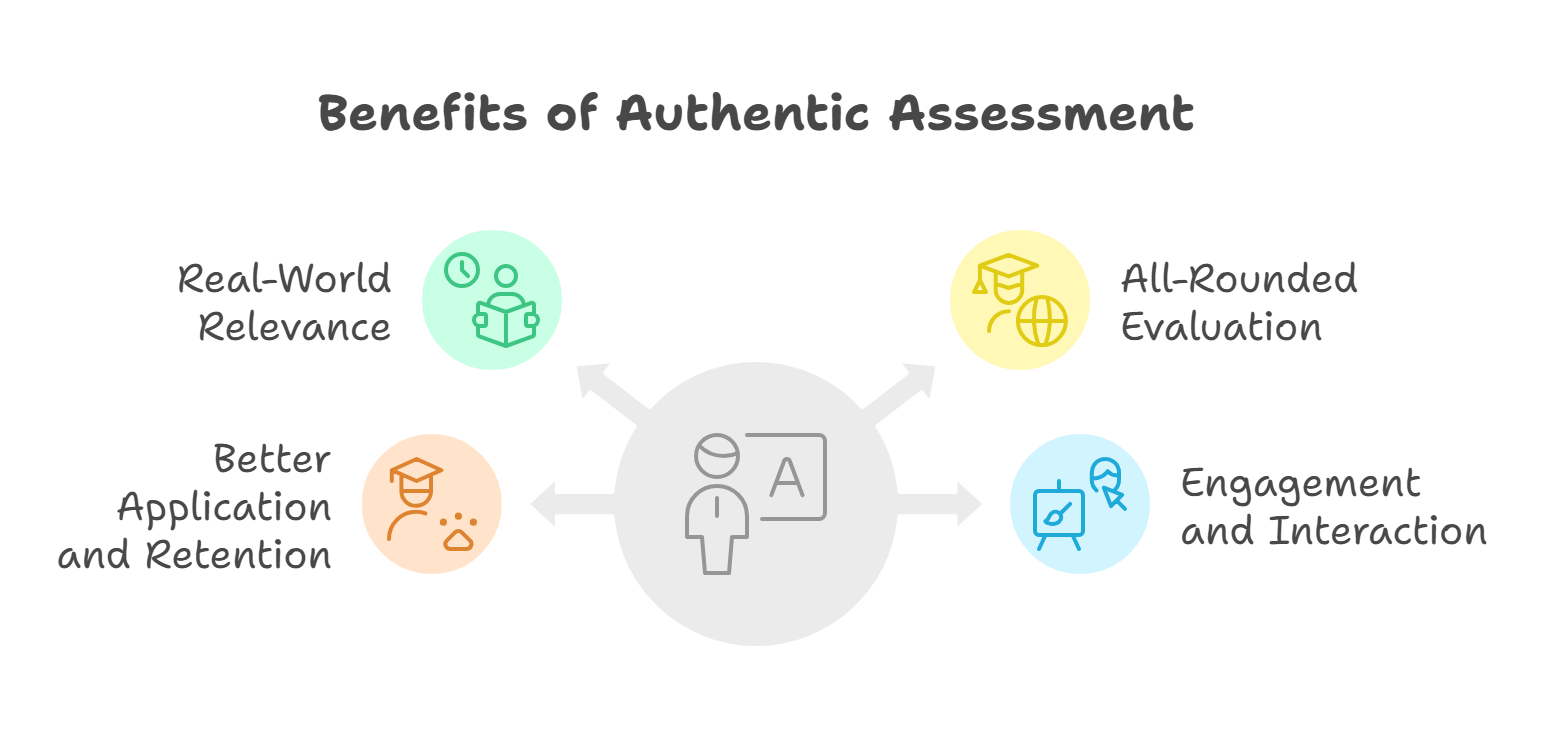
Why Teachers are Shifting to Authentic Assessment
Education institutes understand the growing branches of job prospects in the market, and authentic assessment boosts graduate employability by developing “work-ready” skills in students.
The more diverse the jobs are, the more practical skills they will require. Monitoring and evaluating students using rudimentary methods won’t prepare them for real-life problems.
That is why performance-based assessment is becoming more prevalent. Let’s take a look at some of its benefits over traditional assessment:
1. Relevance in Real World
Online assessment is the future of eLearning, and authentic assessment takes it a step further.
The method closely mirrors the demands and challenges students will likely face in their careers or higher studies. The more familiar they get with such situations, the better their practical skills will be.
2. All-Rounded Evaluation
Being a student-centered assessment method, authentic assessment offers a complete view of their capabilities.
Unlike traditional assessment, it does not prioritize knowledge recall and memorization. The method presents students with tasks that mirror real life and require critical thinking.
Since it motivates learners to analyze information, make connections, and think deeply, it offers educators an overall evaluation.
3. Better Application and Retention
Authentic assessment delivered through online learning provides added benefits. For example, integrating features like gamification can make online learning more engaging and promote higher retention rates.
Since it focuses on implementing skills, the method pushes students to transfer their knowledge to solve issues. Holistic learning and assessments ensure students retain their knowledge beyond the classroom by creating situations and opportunities to apply the skills.
4. Engagement and Interaction
An online assessment test is expected to be the ideal way to track students’ progress. However, if the methods cannot engage students, their learning will be heavily restricted. With authentic assessment, learners are involved in active learning, such as problem-solving tasks and hands-on activities.
Since these activities motivate students to input practical skills, they become more associated with the tasks. Moreover, the method encourages students to present their understanding creatively. Be it vibrant designs, multimedia presentations, or art; holistic assessments lead to engaged and invested students.
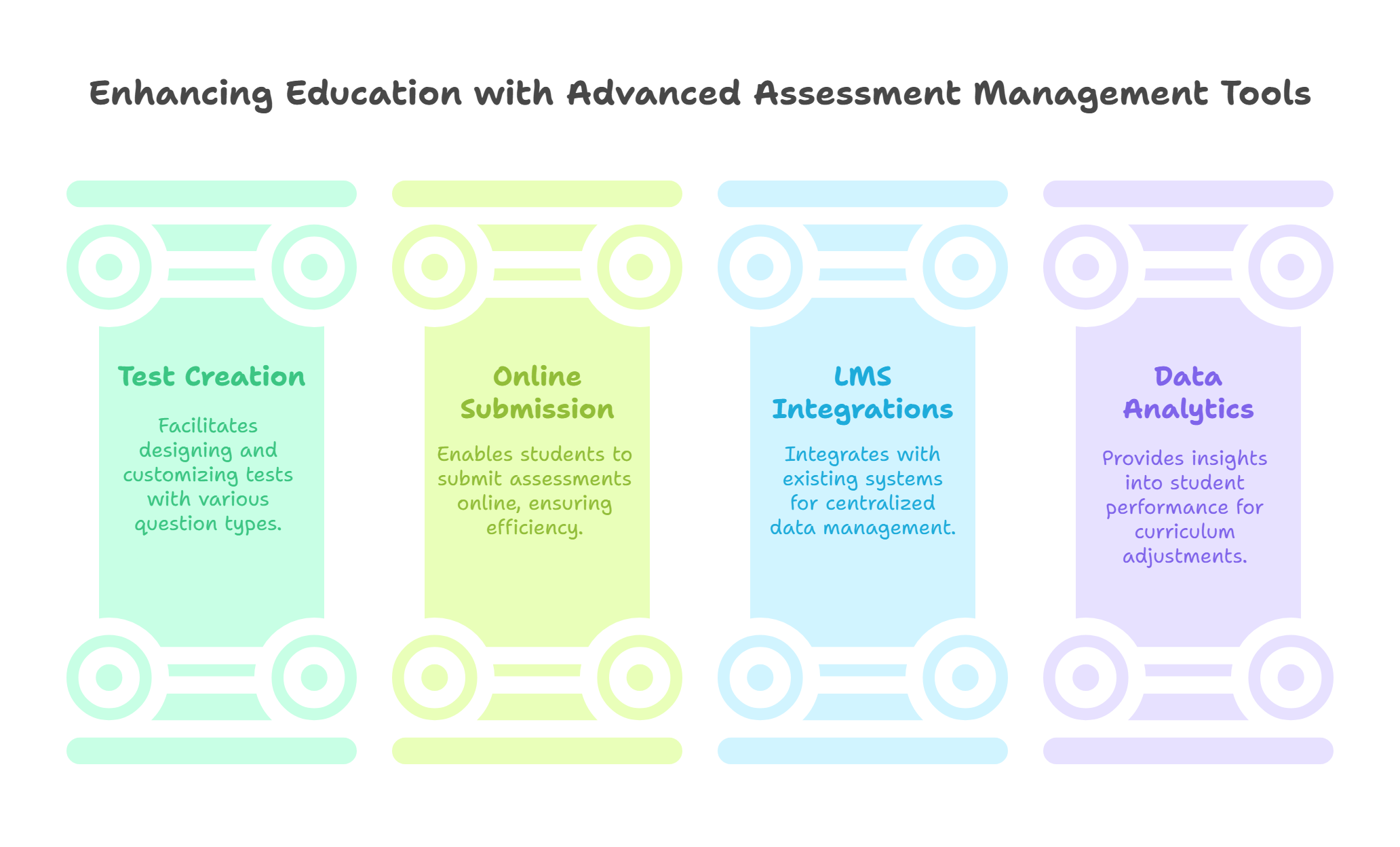
Important Features of Assessment Management Software
Assessment management platforms offer four key features that transform online learning into a developmental experience for learners. These features help educators to organize the coursework into well-formulated modules and help them keep things neat.
1. Test Creation and Customization
Assessment platforms make it extremely easy for teachers to design tests and customize them for students. The platform offers options to insert a variety of questions into the test.
For example, multiple-choice questions, fill-in-the-blanks, subjective-type questions, pick the odd ones out, etc. Furthermore, teachers get the option to adjust the difficulty level of the assessment.
To prevent cheating and dishonesty, these platforms come configured with question randomization and cheating-proof testing that does not allow students to navigate away from the test window. Educators may be able to see their students’ lives through the webcam.
2. Online Submission and Grading
The assessments carried out using this platform are internet-based, eliminating the need for students to be physically present on the premises. All the students need to do is launch the platform on their devices, use their student ID to log in, select the assessment, and complete it within the stipulated time.
The assessment platform has the feature of automatic submission when the time is up, preventing any delays or inefficiencies as they happen in a classroom setting.
Furthermore, these assessment management platforms provide immediate feedback to the students, letting them know their scores, the sections where they performed best, and the areas they need to improve.
3. Integrations with LMS
One of the best features of assessment software is its capability to integrate with your existing ERPs. For example, you can integrate this software with the learning management system in your enterprise.
This provides several key benefits:
- You get centralized access to all assessments submitted by all students enrolled in a course. All this data remains meticulously organized in the LMS.
- You can more readily set up automated performance emails to be sent out to the students who take the assessments by connecting student accounts through the LMS to the assessment management software.
4. Data Analytics and Reporting
The most important feature of assessment management software is its capability to generate detailed reports on individual students. It lets the educators see which students are lagging behind, which students are performing average, which students are excelling, and other data through assessment analysis.
This data helps educators smartly design a flexible curriculum that provides each student with a customizable opportunity to learn at par with their peers.
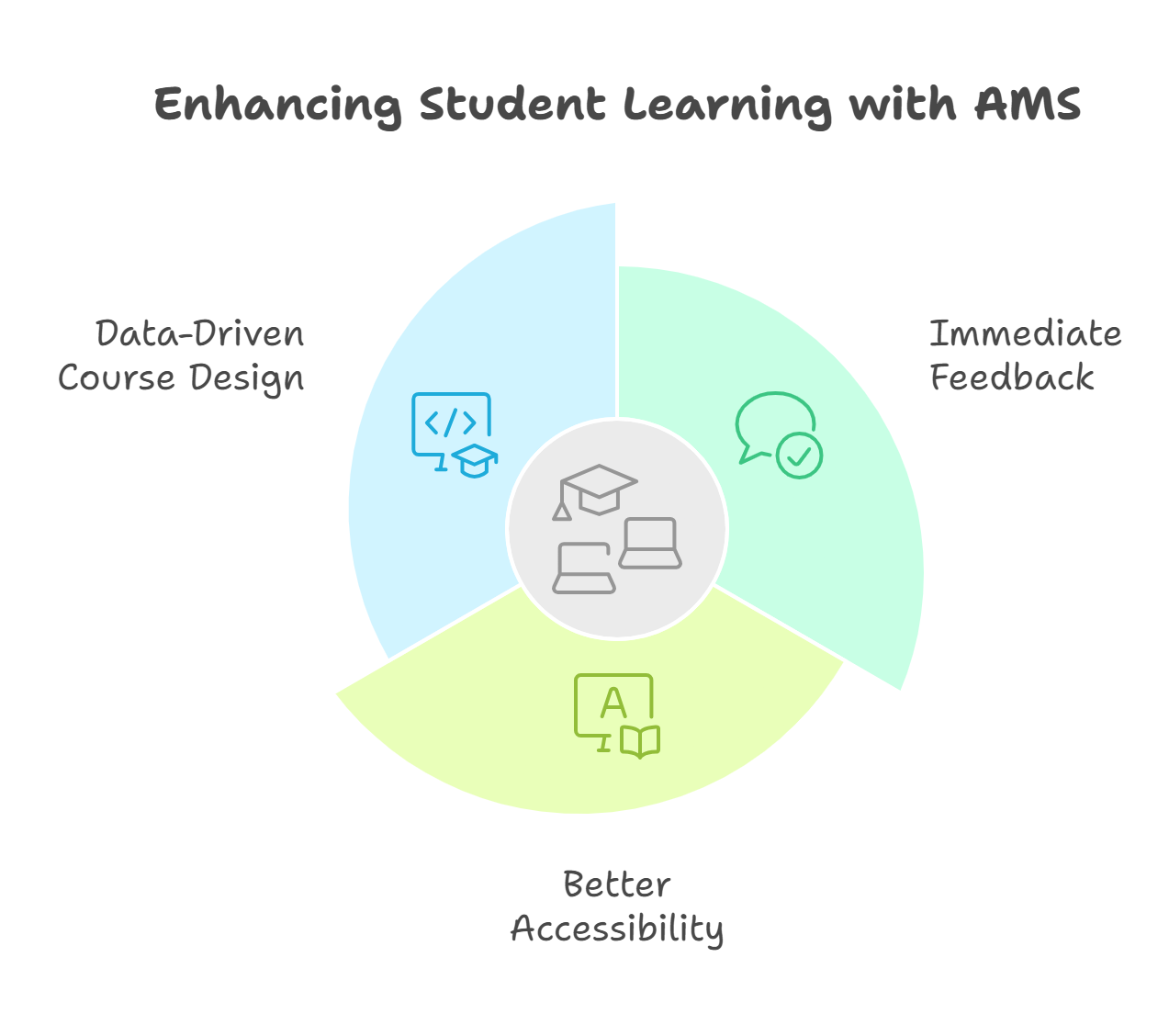
How Does AMS Help Students Enhance Learning?
Educators can tremendously improve the value of a digital or online course to students by employing software for formative assessment and summative assessment.
There are three chief enhancements that assessment platforms provide to students:
1. Immediate and Personalized Feedback
After submitting their assessments, these online platforms provide prompt feedback to the students. The assessment platforms automatically grade each student’s performance for each section of the test.
The students are then served with the reports that contain information about:
- The questions they answered correctly or incorrectly.
- The concepts or subjects they were more comfortable attempting quickly, and the concepts or subjects they took longer to answer.
Countless more metrics are visible to educators as well, enabling them to improve the course based on students’ needs.
2. Better Accessibility
Assessment platforms enhance students’ learning capacity and engagement by drastically improving test accessibility. Since the tests are conducted online and are device responsive, students can access them from anywhere they are free, ready, and available to take them.
For example, students can take the test while traveling on a bus or from the comfort of their homes. By making it easier to conduct assessments, educators can more readily gather student performance data and enhance the course to deliver better value to the learners.
3. Data-Driven Course Design
In the end, a course is only as efficient as the performance of those who enroll for it. A course with an exhaustive learning process may not be as engaging as a course with targeted learning that is interactive and customizable.
Assessment platforms illuminate modules where students are struggling, disengaged, or spinning wheels. This information helps educators improve the delivery of that concept or lesson, making it more engaging and easier to learn.
Understanding Rubrics in Education
A rubric is a scoring tool that determines a specific set of criteria for assessing and articulating certain components for a task or assignment, such as group projects, research papers, presentations, and portfolios.
Rubric-based assessments help instructors grade students’ performances more objectively as they address various issues related to traditional forms of assessment.
Rubrics can be used to assess a range of activities in higher education, such as presentations, term papers, group assignments, and participation expectations. They not only provide a clear and detailed framework for students and educators but also ensure that each element of the assignment is fairly evaluated.
This structured approach allows educators to break down the task into specific, measurable components, making it easier to assess complex assignments comprehensively.
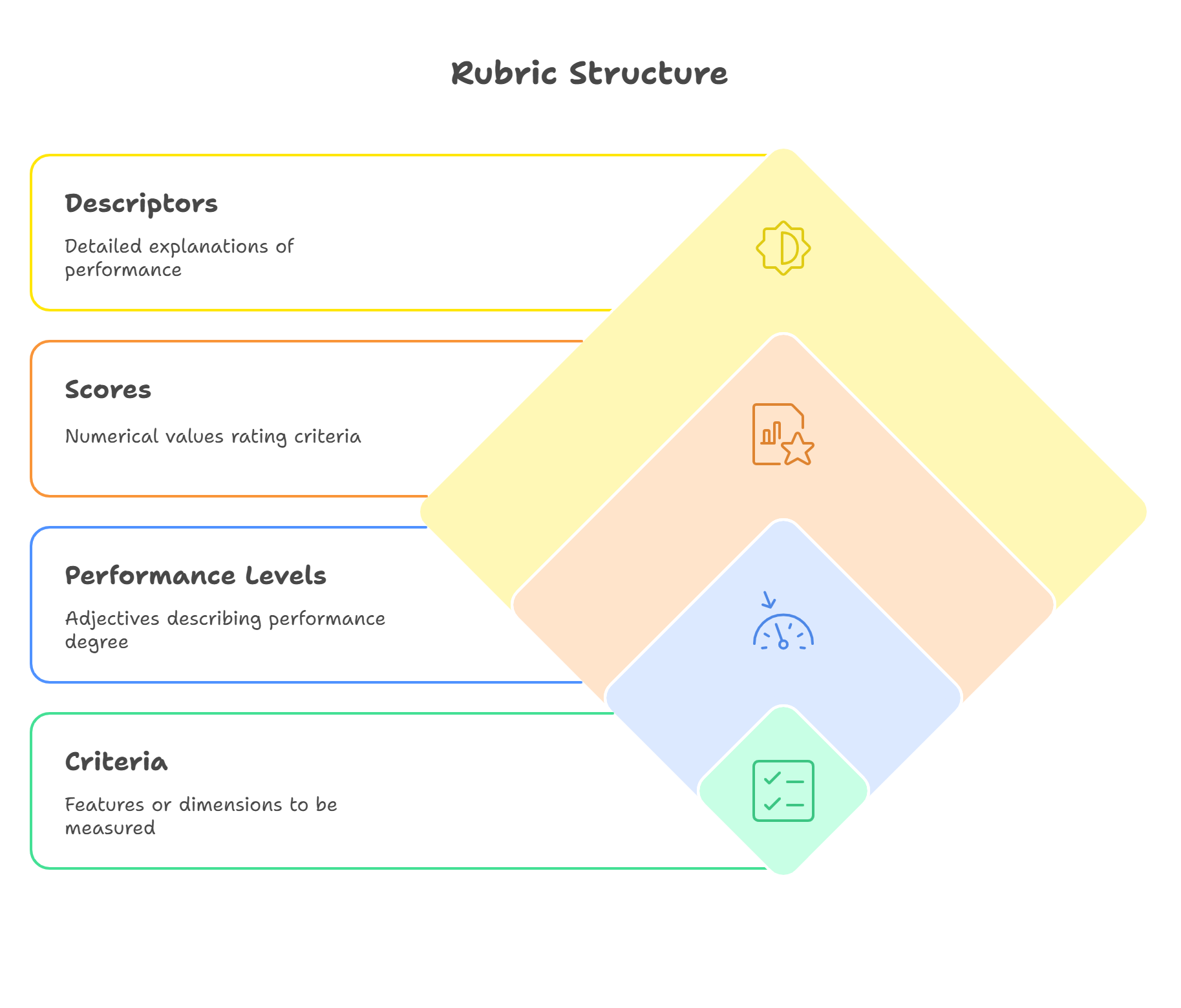
Key Components of a Rubric
Rubrics are typically constructed as a grid-type structure with sections for various elements, such as criteria, scores, levels of performance, and descriptors.
1. Criteria
In rubrics, criteria identify the features, traits, or dimensions that are to be measured. These criteria are defined, and rubric assessment examples are included for better clarity. The criteria are determined from checklists, assignments, and grading sheets.
Criteria for the term paper rubric include the following:
- Introduction
- Analysis
- Grammar
- Punctuation
- Spelling
- Citations
- Conclusion
- References
2. Performance Levels
These are simply adjectives that describe the level of performance. This element determines the degree of performance that has been met and provides for consistent and objective evaluation of the performance.
Performance levels convey to the students what is expected from them and where they need to improve.
Below are words commonly used to describe levels of performance:
- Poor, fair, good, excellent
- Undeveloped, beginning, developing, accomplished, exemplary,
- Beginner, apprentice, master
- Incomplete, complete
3. Scores
Scores refer to the system of values and numbers used to rate the different criteria. They are often combined with performance levels to get an objective evaluation. Instructors determine how many points are needed to describe the range of performance and then decide the scores.
For example:
1, 2, 3, 4, 5 or 5, 10, 15, 20, 25
4. Descriptors
Descriptors explicitly describe the students’ performance and explain how the score is calculated. They also explain the criteria for each level of performance and tell the students what is expected of them.
The descriptors are detailed and give a good idea of what performance at different levels looks like. They help students understand the specific requirements for achieving each level of performance, providing a clear roadmap for success.

Advantages of Implementing Rubrics in Academic Assessment
Using rubrics for assessment is considered one of the topmost assessment best practices due to their objectivity. Both instructors and students enjoy rubrics’ advantages in many ways.
Below are the key advantages of implementing rubrics in academic assessment:
1. Efficient Time Management in Grading
Utilizing rubrics in assessment significantly reduces grading time by providing instructors with a pre-defined, detailed grid. This approach eliminates the need for extensive individual comments, allowing for quicker and more efficient grading.
2. Identifying Student Strengths and Weaknesses
Rubrics offer instructors a precise method for pinpointing students’ strengths and weaknesses. They also make it simple for instructors to assess an entire class’s common strengths and weaknesses and make changes to the curriculum accordingly.
3. Ensuring Fairness and Impartiality in Assessment
Traditional assessment methods can be susceptible to instructor bias. Rubrics help in mitigating this by establishing clear, objective criteria for scoring, ensuring a more equitable evaluation of student performance.
4. Achieving Uniformity in Academic Evaluation
In higher education, rubrics ensure consistent and reproducible scoring, enhancing the precision and reliability of evaluations.
Rubrics use reproducible scoring, which allows for greater precision and reliability in scoring individuals at different levels and multiple individuals in one course. Rubrics can also reduce the uncertainty that often accompanies traditional methods of grading.
5. Enhancing Clarity in Educational Expectations
Using rubrics for assessment allows instructors to organize their thoughts with more clarity.
They provide a framework for prioritizing and assessing criteria effectively, allowing for the potential redesign of course content to better align with learning objectives.
6. Fostering Effective Peer Review Among Students
Rubrics allow for better peer feedback for students. With the help of rubrics, students can provide more accurate peer feedback to others and also self-assess with more precision.
Rubrics help students compare their work to the criteria and understand why they received the score they did.
Wrapping Up
Adaptive learning already has immense potential to help learners gain knowledge on their own terms. Augmenting this pedagogy with an equally efficient assessment method can elevate the value that learners gain from an online course.
Assessment management can be implemented with ease by partnering with experts in the field, like Hurix Digital. Their digital education solutions include implements like learning technology solutions and custom software development that help educators design efficient coursework.
Get in touch with Hurix Digital to know more.
Summarize with:

Senior Vice President
A Business Development professional with >20 years of experience with strong capability to sell new solutions and develop new markets from scratch. New Market Entry Specialist with experience working in the largest emerging markets. Exceptional experience in conceptualizing, ideating and selling new learning technologies like VR AR, etc. across multiple industry verticals.
 A Space for Thoughtful
A Space for Thoughtful 